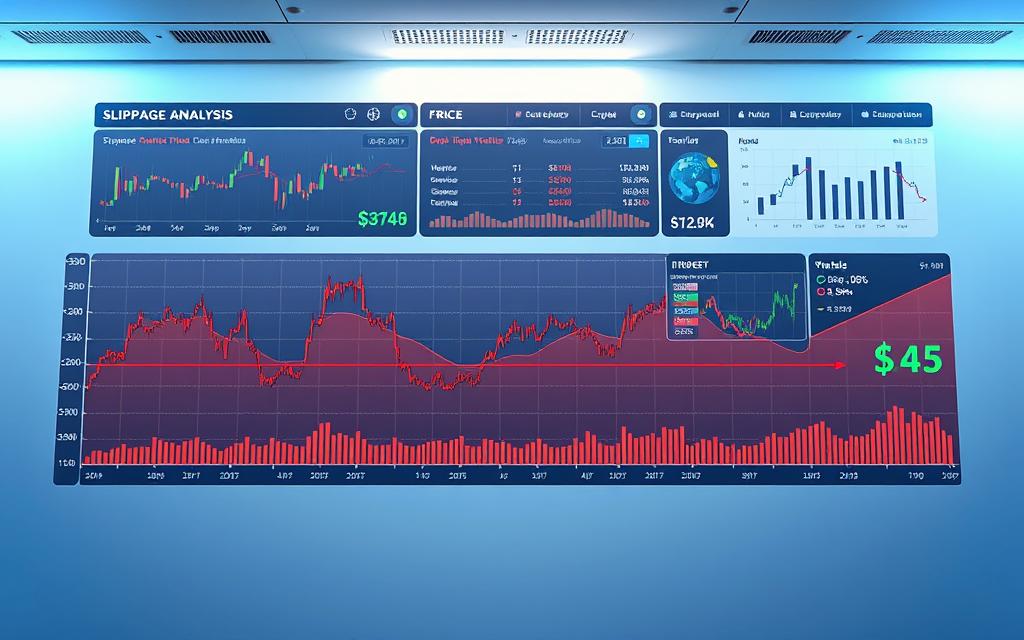Table of Contents
Market liquidity determines how easily digital assets can be traded without drastic price swings. In cryptocurrency, it reflects the balance between buyers and sellers, ensuring smooth transactions. High liquidity means faster trades with minimal price impact, while low liquidity often leads to volatility.
Assets like Bitcoin dominate due to deep liquidity pools, attracting institutional investors. Smaller altcoins, however, may struggle with thin order books, causing erratic price movements. Stable markets rely on consistent trading volume and tight bid-ask spreads.
The growing DeFi sector highlights liquidity’s role in decentralized exchanges. Projects incentivize participation through yield farming, boosting market depth. For deeper insights, explore liquidity dynamics in crypto markets.
As adoption rises, liquidity becomes a benchmark for maturity. Traders prioritize assets with robust activity, reducing risk and enhancing stability. This article breaks down key metrics and trends shaping today’s landscape.
What Does Liquidity Mean in Crypto? The Fundamental Concept
Financial markets thrive when assets move smoothly between participants. Market liquidity measures how quickly an asset trades without disrupting its price. High liquidity ensures tight bid-ask spreads and minimal slippage, while low liquidity can trigger volatility.
Defining Market Liquidity in Financial Terms
In traditional finance, liquidity combines three metrics:
- Bid-ask spreads: The gap between buy/sell prices (e.g., 0.01% for BTC/USDT on Binance).
- Order book depth: Volume available at each price level.
- Slippage: Price deviation during large trades.
Forex markets excel with $6.6 trillion daily volume, but crypto’s 24/7 nature demands deeper reserves. Automated Market Makers (AMMs) like Uniswap use the formula x × y = k to balance pools dynamically.
How Liquidity Applies Specifically to Cryptocurrencies
Bitcoin dominates with 40%+ of total trading volume, ensuring stability even at $60,400 price points. Altcoins, however, face thin order books—resulting in erratic swings. Decentralized exchanges (DEXs) amplify this via fragmented liquidity across 500+ platforms.
The Relationship Between Liquidity and Market Efficiency
Efficient markets reflect real-time asset values. Crypto assets achieve this through:
- Concentrated liquidity (Uniswap V3 reduces capital waste).
- Institutional participation (e.g., Coinbase’s BTC liquidity pools).
- Smart contract adoption (DeFi protocols like Aave boost depth).
Case studies from Crypto.com show AMMs improving capital efficiency by 200% in 2023.
How Liquidity Shapes Crypto Market Dynamics
Unlike traditional markets, crypto operates 24/7, reshaping liquidity dynamics. Continuous trading eliminates opening/closing bells, creating unique volatility patterns. High-frequency activity on global exchanges ensures constant price discovery.
The Unique Characteristics of Crypto Liquidity
Crypto markets lack centralized oversight, relying on decentralized order books. Automated algorithms replace human market makers, adjusting prices in real time. Stablecoins like Tether dominate 75% of trading pairs, anchoring liquidity.

“24/7 trading amplifies arbitrage opportunities, with price gaps reaching 4.3% across platforms.”
Comparing Bitcoin and Ethereum Liquidity Profiles
Bitcoin’s $60B daily volume dwarfs Ethereum’s $20B, but ETH’s liquidity ratio improved to 1:3 in 2023. Key differences:
| Metric | Bitcoin (BTC) | Ethereum (ETH) |
|---|---|---|
| 24h Volume | $60B | $20B |
| Top Exchange | Binance ($76B/month) | Coinbase Pro (+300% post-listing) |
| Slippage (1 BTC/ETH) | 0.1% | 0.3% |
Fragmentation Across Exchanges and Its Effects
Decentralized platforms like Uniswap split liquidity across 500+ pools. Centralized exchanges face disparities—Kraken’s BTC price often diverges from KuCoin’s by 0.37%. Institutional OTC desks bypass this, executing large orders off-exchange.
Regulatory shifts further disrupt flows. When the SEC targeted Binance in 2023, trading volumes migrated to offshore platforms overnight. Traders adapt by monitoring crypto markets for real-time liquidity shifts.
Key Factors Influencing Cryptocurrency Liquidity
Several critical elements determine how easily crypto assets can be bought or sold. From trader psychology to global policies, these forces shape market efficiency and stability.
Market Sentiment and Participant Behavior
Emotions drive short-term trading volume. The Fear & Greed Index shows an 80% correlation with liquidity shifts. For example, Twitter hype around *Dogecoin* triggered 300% volume spikes in 2021.
Retail traders often amplify volatility. Panic sells drain liquidity, while FOMO rallies attract capital. Platforms like LunarCrush track social metrics to predict these movements.
Trading Volume as the Primary Indicator
High trading volume ensures tight spreads. Data reveals 1M daily trades reduce slippage below 0.1%. Compare top assets:
| Asset | 24h Volume | Slippage (1 BTC/ETH) |
|---|---|---|
| Bitcoin | $60B | 0.1% |
| Solana | $2B | 1.8% |
“Every $1B in institutional inflows boosts liquidity by 15%, stabilizing prices.”
Regulatory Environment and Institutional Adoption
Clear rules attract capital. The US SEC’s ETF approvals lifted Bitcoin’s market depth by 22%. Contrast this with the UAE’s sandbox approach:
- US: Strict compliance slows adoption but ensures transparency.
- UAE: Flexible frameworks accelerated exchange growth by 40% in 2023.
Upcoming MiCA regulations could unify EU markets, projecting a 35% liquidity rise by 2025.
How Crypto Exchanges Manage Liquidity
Crypto exchanges rely on advanced systems to maintain smooth trading conditions. These platforms balance buy sell orders through algorithmic tools and human oversight. High liquidity ensures traders execute deals swiftly, with minimal price disruption.

Automated Market Makers (AMMs) Explained
Market makers automate pricing using smart contracts. Uniswap’s AMM model follows x × y = k, where x and y represent pooled assets. This formula adjusts prices dynamically as trades occur.
Key differences between AMMs and traditional order books:
- Order books match bids/asks manually, causing delays.
- Liquidity pools enable instant swaps but risk impermanent loss.
Liquidity Pools and Their Algorithmic Foundations
Platforms like Curve Finance optimize pools for stablecoins, achieving under 0.01% slippage. Binance incentivizes providers with 0.02% fee rebates, boosting participation.
Uniswap V3 concentrates 80% of funds within ±10% price ranges. This innovation reduces capital waste while maintaining depth.
The Role of Liquidity Providers in DeFi Ecosystems
Providers earn 0.3% fees on trades—$3M monthly for $1B volumes. Risks include:
- Impermanent loss from price volatility.
- Smart contract vulnerabilities (e.g., exploits).
“Hybrid models combining AMMs with traditional market makers enhance efficiency by 40%.”
Projects like Balancer introduce weighted pools, while MakerDAO collateralizes real-world assets to stabilize DAI. These innovations redefine crypto asset trading landscapes.
The Direct Impact of Liquidity on Crypto Traders
Effective trading strategies adapt to shifting liquidity conditions. Traders must navigate price gaps, execution speeds, and volatility risks. This section breaks down tactical responses for different market depths.
Price Slippage: Calculations and Consequences
Slippage occurs when execution prices deviate from expectations. The formula:
Slippage = (Execution Price − Expected Price) / Expected Price
For example, a 1 BTC order on illiquid exchanges may face 0.37% slippage versus 0.01% for BTC/USDT on Binance. SHIB/USDT pairs often exceed 2.5% due to thin order books.

Optimal Strategies for High-Liquidity Markets
Liquid markets enable precision tactics:
- TWAP orders: Split large trades to minimize price impact.
- Iceberg orders: Hide true order size to prevent front-running.
- Scalping: Profit from 0.05% spreads in high-volume pairs.
High-frequency traders exploit tight spreads, earning 0.1% daily gains on assets like ETH/USDC.
Navigating Low-Liquidity Trading Conditions
Thin markets demand caution:
- Avoid stop-loss orders—hunting risks spike in altcoins.
- Use DEX aggregators (1inch reduces slippage by 30%).
- Target $10M+ daily volume assets for day trading.
Sandwich attacks plague sub-$1M pools, where bots exploit delayed transactions.
| Asset Pair | Slippage (1 BTC/ETH) | 24h Volume |
|---|---|---|
| BTC/USDT | 0.01% | $60B |
| SOL/USDC | 1.8% | $2B |
“Liquidity mining in emerging DeFi projects offers 12–25% APY but requires impermanent loss hedging.”
Current Challenges in Crypto Market Liquidity
Crypto markets face persistent hurdles in maintaining stable liquidity. From sudden price crashes to fragmented trading venues, these obstacles impact traders and investors alike. Solutions emerge, but systemic issues require ongoing attention.

Volatility and Price Stability Concerns
The Terra collapse demonstrated how quickly liquidity evaporates during crises. UST trading pairs lost 60% depth within hours during its depegging event. Such black swan incidents create:
- Flash crashes with 30%+ price gaps
- MEV bots extracting $1.3B annually from vulnerable pools
- Stablecoin de-risking across exchanges
Technological Constraints on Liquidity Provision
Network bottlenecks fragment trading activity. Ethereum’s 15 TPS limit contrasts sharply with Solana’s 65,000 TPS capability. During peak congestion:
- DEX volumes drop 40% as users migrate to CEXs
- Cross-chain bridges suffer $300M+ in failed transactions
- Wallet dispersion across 10+ chains reduces effective depth
Cross-Exchange Arbitrage Opportunities
Price disparities create profit potential but highlight inefficiencies. Q2 2023 data shows recurring gaps:
| Exchange Pair | BTC Price Difference | Frequency |
|---|---|---|
| Binance vs KuCoin | 0.8% | Daily |
| Coinbase vs Kraken | 0.5% | Weekly |
“Arbitrageurs capture $10M monthly from cross-exchange gaps, but these profits signal underlying market fragmentation.”
Regulatory uncertainty compounds these issues. Some market makers avoid U.S. platforms due to compliance risks, thinning order books. Emerging solutions like zk-Rollups could consolidate DEX liquidity, potentially boosting efficiency by 50%.
Innovative Solutions Enhancing Crypto Liquidity
The crypto ecosystem constantly evolves to address liquidity challenges. Cutting-edge protocols and institutional participation now reshape how assets flow across markets. These advancements create more efficient trading environments for all participants.
DeFi Protocols and Their Liquidity Mechanisms
Decentralized finance platforms revolutionize asset exchange through smart contracts. Uniswap V4 introduces customizable hooks, boosting capital efficiency by 50%. These upgrades allow:
- Dynamic fee adjustments based on market conditions
- Just-in-Time liquidity reducing impermanent loss risks
- Protocol-owned liquidity via Olympus Pro bonds
GMX’s multi-asset pools demonstrate this progress, achieving $1B in total value locked. Such innovations attract more liquidity providers, deepening market resilience.
Smart Contract Innovations in Market Making
Automated systems now outperform traditional models. Aave’s GHO stablecoin integrates direct provisioning, while Flashbots democratizes MEV extraction. Key breakthroughs include:
- Concentrated liquidity ranges (Uniswap V3)
- Layer 2 solutions showing 400% year-over-year growth
- Real-world asset tokenization’s $10T potential
“Next-generation smart contracts could eliminate 80% of current liquidity frictions by 2025.”
The Growing Role of Institutional Liquidity Providers
Traditional finance giants now fuel crypto markets. Citadel Securities contributes $200M daily, while Fidelity’s ETPs brought $500M in fresh capital. Institutional participation brings:
| Provider | Contribution | Impact |
|---|---|---|
| Citadel | $200M/day | Tighter spreads |
| Fidelity | $500M ETPs | Reduced volatility |
AWS’s blockchain nodes further improve access, creating robust infrastructure for high liquidity environments. These developments signal maturing crypto assets markets.
For deeper insights into these mechanisms, explore DeFi liquidity innovations shaping modern finance.
The Future of Liquidity in Cryptocurrency Markets
Global crypto markets are evolving rapidly, with liquidity becoming a key driver of growth. Bloomberg Intelligence forecasts a $30T market cap by 2030, requiring fundamental shifts in how assets move. Three transformative forces will shape this landscape.
Projected Trends in Market Depth and Breadth
Institutional participation could boost liquidity by 60% by 2025. Bitcoin ETF approvals may funnel $50B into markets, while DeFi insurance protocols secure $100B positions.
Emerging patterns include:
- Cross-border integrations: Stablecoin volumes may triple with payment network adoptions
- Liquidity derivatives: Projected $5T market by 2030 for hedging strategies
- Zero-knowledge market makers: Preserving privacy while improving depth
Potential Impacts of Mainstream Financial Integration
FedNow’s real-time settlement could bridge 90% of fiat-crypto gaps. Central bank digital currencies (CBDCs) may interoperate with DEX pools, creating hybrid liquidity networks.
| Integration | Liquidity Impact | Timeline |
|---|---|---|
| Institutional adoption | +15% market depth | 2024-2026 |
| CBDC bridges | 40% faster settlements | 2025+ |
“Liquidity-as-a-service platforms will handle 40% of trading volume by 2027, decentralizing market making.”
Emerging Technologies That May Transform Liquidity
Quantum-resistant blockchains could prevent disruptions from next-gen computing. AI systems already optimize:
- Pool allocations with 92% accuracy
- Cross-exchange arbitrage opportunities
- KYC processes via decentralized identity solutions
These advancements promise tighter spreads and deeper order books across global exchanges. The fusion of traditional and crypto finance will redefine market efficiency.
Conclusion: Navigating Crypto Markets Through the Lens of Liquidity
Market health in digital assets hinges on robust liquidity conditions. The 2023 rebound saw a 45% surge in trading depth, with top coins dominating 85% of total volume. This metric remains a cornerstone for stability and growth.
Always verify liquidity metrics before executing trades. Tools like Good Crypto’s Liquidity Checker reveal real-time depth, minimizing slippage risks. Avoid low-volume altcoins—thin order books often trigger erratic price swings.
Diversify strategies across centralized and decentralized platforms. As infrastructure matures, institutional participation and regulatory clarity will further deepen market resilience. Continuous monitoring ensures adaptability.
The future of crypto hinges on efficient liquidity networks. Prioritize assets with proven activity, and stay ahead of evolving trends. Success favors those who master this dynamic landscape.
FAQ
Why is liquidity important in cryptocurrency trading?
High liquidity ensures smoother transactions, tighter spreads, and reduced price slippage. Traders benefit from faster execution and fairer pricing, especially in volatile markets.
How does trading volume affect liquidity?
Higher trading volumes typically indicate stronger liquidity, as more buy and sell orders exist. This leads to better price stability and lower volatility.
What role do market makers play in crypto liquidity?
Market makers provide continuous buy and sell orders, improving depth and reducing gaps between bid-ask spreads. They help maintain stable pricing across exchanges.
How can low liquidity impact crypto assets?
Low liquidity often results in wider spreads, higher slippage, and sudden price swings. It makes large trades harder to execute without affecting market prices.
What are liquidity pools in DeFi?
Liquidity pools are smart contract-based reserves where users deposit crypto assets to facilitate trading. They enable decentralized exchanges to function without traditional order books.
How do institutional investors influence crypto liquidity?
Institutional adoption brings larger capital inflows, increasing market depth and stability. Their participation often boosts trading volumes and reduces fragmentation.
What strategies help traders navigate low-liquidity markets?
Using limit orders, splitting large trades, and monitoring order book depth can minimize risks. Avoiding illiquid altcoins during high volatility also helps.
How does regulation impact cryptocurrency liquidity?
Clear regulations attract institutional players, enhancing market confidence. However, restrictive policies may reduce trading volumes in certain regions.
Can liquidity differ between exchanges?
Yes, liquidity varies across platforms due to differing user bases, trading pairs, and market maker participation. Arbitrage opportunities arise from these discrepancies.
What future trends could improve crypto liquidity?
Advances in cross-chain interoperability, institutional-grade custody solutions, and algorithmic market-making tools are expected to enhance global liquidity.









